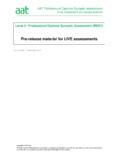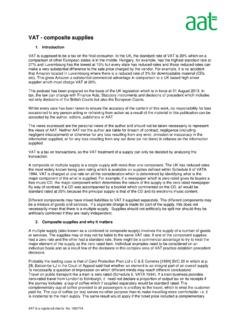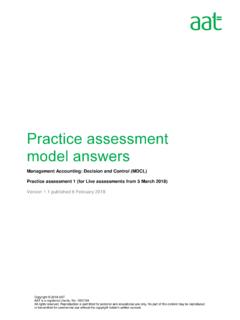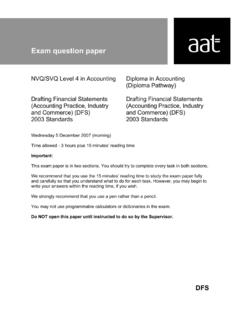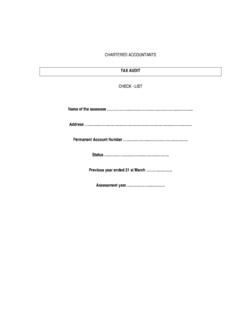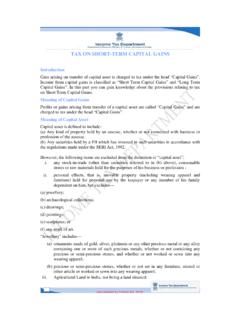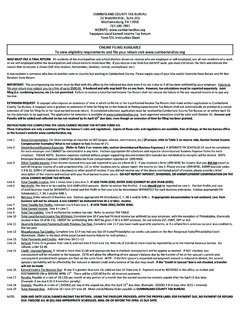Transcription of Professional conduct in relation to taxation
1 Copyright 2016 AAT All rights reserved. Reproduction is permitted for personal and educational use only. No part of this content may be reproduced or transmitted for commercial use without the copyright holder s written consent. 1 Professional conduct in relation to taxation Extracts relevant for Personal Tax (PLTX) unit AQ2016 Copyright 2016 AAT All rights reserved. Reproduction is permitted for personal and educational use only. No part of this content may be reproduced or transmitted for commercial use without the copyright holder s written consent. 2 1. Introduction 1. Interpretation and abbreviations .. 3 Context .. 3 Interpretation .. 3 Abbreviations .. 3 2.
2 Fundamental principles .. 4 Overview of the fundamental principles .. 4 3. Tax returns .. 5 Definition of tax return (return) .. 5 Materiality .. 5 Disclosure .. 6 Supporting documents .. 7 4. Tax advice .. 8 Introduction .. 8 Tax planning vs tax avoidance? .. 8 Member s responsibility in giving tax planning advice .. 8 5. Irregularities .. 10 Introduction .. 10 Steps to take if there is a possible irregularity .. 11 6. Access to data by HMRC .. 12 Introduction .. 12 Informal requests addressed to the client .. 13 Statutory requests addressed to the 13 Statutory requests addressed to the member .. 13 Privileged data .. 14 Copyright 2016 AAT All rights reserved. Reproduction is permitted for personal and educational use only.
3 No part of this content may be reproduced or transmitted for commercial use without the copyright holder s written consent. 3 1. Interpretation and abbreviations Context Tax advisers operate in a complex business and financial environment. The increasing public focus on the role of taxation in wider society means a greater interest in the actions of tax advisers and their clients. This guidance, written by the Professional bodies for their members working in tax, sets out the hallmarks of a good tax adviser, and in particular the fundamental principles of behaviour that members are expected to follow. Interpretation In this guidance: Client includes, where the context requires, former client.
4 Member (and members ) includes firm or practice and the staff thereof. For simplicity, she and her are used throughout but should be taken to include he and his . Words in the singular include the plural and words in the plural include the singular. Abbreviations The following abbreviations have been used: CCAB Consultative Committee of Accountancy Bodies DOTAS Disclosure of Tax Avoidance Schemes GAAP Generally Accepted Accounting Principles GAAR General Anti-Abuse Rule in Finance Act 2013 HMRC Her Majesty s Revenue and Customs MLRO Money Laundering Reporting Officer NCA National Crime Agency (previously the Serious Organised Crime Agency, SOCA) POTAS Promoters of Tax Avoidance Schemes SRN Scheme Reference Number Copyright 2016 AAT All rights reserved.
5 Reproduction is permitted for personal and educational use only. No part of this content may be reproduced or transmitted for commercial use without the copyright holder s written consent. 4 2. Fundamental principles Overview of the fundamental principles Ethical behaviour in the tax profession is critical. The work carried out by a member needs to be trusted by society at large as well as by clients and other stakeholders. What a member does reflects not just on themselves but on the profession as a whole. A member must comply with the following fundamental principles: Integrity To be straightforward and honest in all Professional and business relationships. Objectivity To not allow bias, conflict of interest or undue influence of others to override Professional or business judgements.
6 Professional competence and due care To maintain Professional knowledge and skill at the level required to ensure that a client or employer receives competent Professional service based on current developments in practice, legislation and techniques and act diligently and in accordance with applicable technical and Professional standards. Confidentiality To respect the confidentiality of information acquired as a result of Professional and business relationships and, therefore, not disclose any such information to third parties without proper and specific authority, unless there is a legal or Professional right or duty to disclose, nor use the information for the personal advantage of the member or third parties.
7 Professional behaviour To comply with relevant laws and regulations and avoid any action that discredits the profession. Each of these fundamental principles is discussed in more detail in the context of taxation services. Copyright 2016 AAT All rights reserved. Reproduction is permitted for personal and educational use only. No part of this content may be reproduced or transmitted for commercial use without the copyright holder s written consent. 5 3. Tax returns Definition of tax return (return) For the purposes of this Chapter, the term return includes any document or online submission of data that is prepared on behalf of the client for the purposes of disclosing to any taxing authority details that are to be used in the calculation of tax due by a client or a refund of tax due to the client or for other official purposes and, for example, includes: Self-assessment returns for income or corporation tax; VAT and Customs returns; PAYE returns; Inheritance tax returns; Returns or claims in respect of any other tax or duties where paid to the UK Government or any authority, such as a devolved government.
8 A letter giving details in respect of a return or as an amendment to a return including, for example, any voluntary disclosure of an error should be dealt with as if it was a return. Taxpayer s responsibility The taxpayer has primary responsibility to submit correct and complete returns to the best of her knowledge and belief. The return may include reasonable estimates where necessary. It follows that the final decision as to whether to disclose any issue is that of the client. Member s responsibility A member who prepares a return on behalf of a client is responsible to the client for the accuracy of the return based on the information provided. In dealing with HMRC in relation to a client s tax affairs a member must bear in mind her duty of confidentiality to the client and that she is acting as the agent of her client.
9 She has a duty to act in the best interests of her client. A member must act in good faith in dealings with HMRC in accordance with the fundamental principle of integrity. In particular the member must take reasonable care and exercise appropriate Professional scepticism when making statements or asserting facts on behalf of a client. Where acting as a tax agent, a member is not required to audit the figures in the books and records provided or verify information provided by a client or by a third party. A member should take care not to be associated with the presentation of facts she knows or believes to be incorrect or misleading nor to assert tax positions in a tax return which she considers have no sustainable basis.
10 When a member is communicating with HMRC, she should consider whether she needs to make it clear to what extent she is relying on information which has been supplied by the client or a third party. Materiality Whether an amount is to be regarded as material depends upon the facts and circumstances of each case. The profits of a trade, profession, vocation or property business must be computed in accordance with GAAP subject to any adjustment required or authorised by law in computing profits for those Copyright 2016 AAT All rights reserved. Reproduction is permitted for personal and educational use only. No part of this content may be reproduced or transmitted for commercial use without the copyright holder s written consent.

